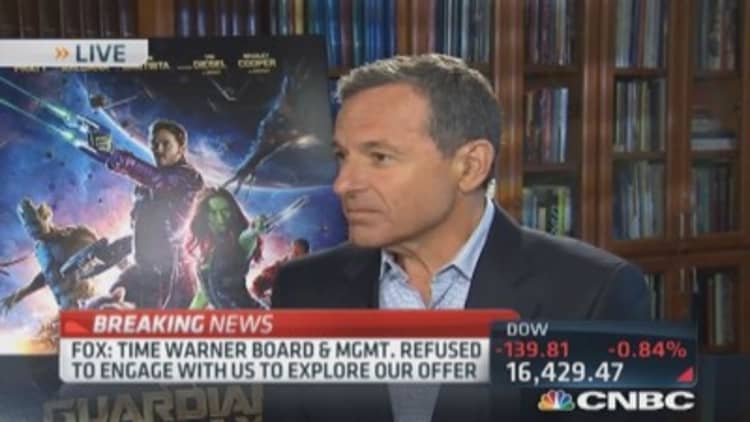Audiences seem to be falling out of love with traditional fairy tales and their obligatory "happy endings."
From social media to photography, artists worldwide are putting darker spins on children stories, forcing one organization that has relied on "happily ever after" for more than 75 years to give its stories a makeover.
Walt Disney Pictures has been the frontrunner for animated versions of beloved children's tales since 1923. However, its most popular output recently has been its live-action films.
Now the company has overhauled the fairy tale framework to release contemporary interpretations of traditional tales including "Oz, The Great and Powerful" and "Maleficent."
Read MoreUnmasking Hollywood
This Christmas, Disney releases "Into The Woods," Rob Marshall's interpretation of Stephen Sondheim's musical about classic fairy tales including "Jack and Beanstalk" and "Rapunzel."
Disney isn't the only film distributor to cash in on retelling stories for a new generation—and the parents who take them to the movies. Warner Brothers' "Jack & the Giant Slayer" and "Red Riding Hood;" Universal Pictures' (part of NBCUniversal, parent of CNBC) "Snow White and The Huntsman;" and Paramount Pictures' "Hansel & Gretel: Witch Hunters" have all followed the trend since 2010.
With "Maleficent" grossing $757 million globally so far this year, Disney is likely to keep the trend going. It has future adaptations of "Cinderella" and "Jungle Book" set to be released in 2015. Rumored projects in development also include "Beauty and the Beast" and "Dumbo."
What's significant about these adaptations—both fairy tale and children's beloved stories—is the lengths Disney will go to reconfigure its original.
Jeff Bock, senior box office analyst at Exhibitor Relations Co, told CNBC via email about the relationship that Disney has with fairy tales as a never-ending one.
"Every generation has been brought up on these films, so adapting them from animated to live-action is appealing not only from a monetary standpoint but to lure new generations," Bock said. "The success of 'Maleficent,' and likely 'Cinderella' this spring, is a huge reason why these adaptations will continue. And the fact is, outside of Disney, fairy tales haven't done too well except for Universal's 'Snow White and the Huntsman.' There is definitely something about that Disney magic!"
And it's not just the format that has changed in these recent films. In "Maleficent," "Oz, The Great and Powerful," and "Alice in Wonderland," Disney has changed the main character, period, and even the classic ending.
Dr. Elizabeth Dearnley, a research associate at the School of European Languages, Culture and Society, told CNBC via email that "several recent versions challenge our perceptions of which characters are the heroes and which are the villains. This can partly be traced back to the idea of fairy tales being subversive; the kaleidoscope of story elements can always be shaken again to bring out a fresh meaning."

Fairy tales take to the Internet
It's not just the movie industry that wants a slice of the fairy tale pie. Popular TV series "Once Upon a Time" and "Grimm" both gained more than 7.9 million viewers on average per episode during the 2013-2104 season, according to Deadline Hollywood and Nielsen's data.
In 2007, photographer Dina Goldstein has launched "Fallen Princesses," a portfolio depicting Disney princesses in modern settings, including Belle undergoing plastic surgery and Rapunzel losing her hair through chemotherapy.
Goldstein told Cargoh, an online marketplace for artists, that the project was about Disney Princesses "after the happily ever after" and how they would "have to deal with challenges that all modern women face."
Artist 'Sakimichan' transforms Disney and other fictional characters through gender swaps or 'humanisations,' including a human Bugs Bunny and a male Cruella De Vil.
Dr. Dearnley says fairy tales are "successful because they stick effectively in people's brains and make people want to pass them on, telling them a little differently each time."


